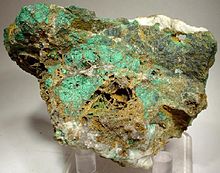| Cornwallite | |
|---|---|
 Cornwallite in a vug from Pastrana, Murcia, Spain (size: 4.3 × 3.7 × 2.2 cm) | |
| General | |
| Category | Arsenate mineral |
| Formula (repeating unit) | Cu5(AsO4)2(OH)4 |
| IMA symbol | Cnw[1] |
| Strunz classification | 8.BD.05 |
| Dana classification | 41.4.2.2 |
| Crystal system | Monoclinic |
| Crystal class | Prismatic (2/m) (same H-M symbol) |
| Space group | P21/c |
| Unit cell | a = 17.33 Å, b = 5.82 Å, c = 4.60 Å; β = 92.22°; Z = 2 |
| Identification | |
| Color | Verdigis green, blackish-green, emerald-green |
| Crystal habit | Microcrystalline radial fibrous, botryoidal to globular crusts |
| Cleavage | Distinct in one direction |
| Fracture | Conchoidal |
| Tenacity | Brittle |
| Mohs scale hardness | 4.5 |
| Luster | Sub-vitreous, resinous, waxy |
| Streak | Apple green |
| Diaphaneity | Translucent to opaque |
| Specific gravity | 4.17 |
| Optical properties | Biaxial (+/−) |
| Refractive index | nα = 1.810 – 1.820 nβ = 1.815 – 1.860 nγ = 1.850 – 1.880 |
| Birefringence | δ = 0.040 – 0.060 |
| 2V angle | Measured: 30° to 50° |
| References | [2][3][4][5] |
Cornwallite is an uncommon copper arsenate mineral with formula Cu5(AsO4)2(OH)4. It forms a series with the phosphate pseudomalachite and is a dimorph of the triclinic cornubite. It is a green monoclinic mineral which forms as radial to fibrous encrustations.

- ^ Warr, L.N. (2021). "IMA–CNMNC approved mineral symbols". Mineralogical Magazine. 85 (3): 291–320. Bibcode:2021MinM...85..291W. doi:10.1180/mgm.2021.43. S2CID 235729616.
- ^ Mineralienatlas
- ^ Cornwallite in the Handbook of Mineralogy
- ^ Cornwallite on Mindat.org
- ^ Cornwallite data on Webmineral